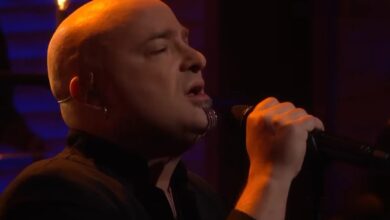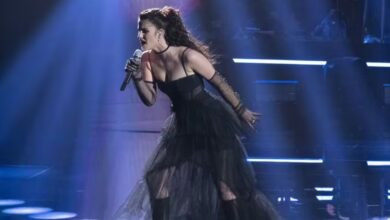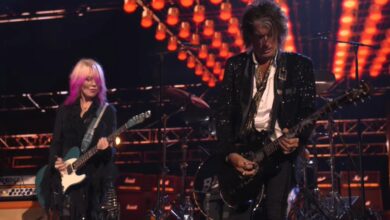Sisters of Rock Turn “These Dreams” Into Living Poetry in 2025
When Heart returned to Edmonton on March 21, 2025, it felt less like a concert and more like a gathering of old companions who had endured decades together. At Rogers Place, the Wilson sisters leaned on a catalog that had matured alongside their fans. “These Dreams” emerged as the evening’s quiet storm—more about memory, survival, and the endurance of melody than spectacle. Part of the Royal Flush Tour, the show carried the glow of gratitude even before a single chord rang out.
The venue gave the song its own canvas. Rogers Place, far newer than the arenas where Heart once proved their dominance, framed the performance in a modern yet intimate way. With the lights softened, the crowd hushed, and guitar tones shimmering like faint beams in mist, the ballad unfolded with reverence. Edmonton had waited patiently, and the band answered not with bombast but with subtlety, perfectly matching the song’s dreamlike character.
This date was one link in a tightly packed Canadian stretch—Calgary the night before, Winnipeg soon after. The routing showed a determination to reclaim ground after earlier postponements: no tentative steps, no easing in. In that light, “These Dreams” carried the weight of a declaration, reminding all that while bodies may tire and tours may pause, the spirit of the music refuses to fade.
For longtime fans, the magic was hearing the song exactly as it first arrived in 1986—with Nancy Wilson handling lead vocals. The familiar timbre that once dominated radio waves and climbed to No. 1 on the Billboard Hot 100 returned, now colored with years of experience. The audience leaned closer as soon as the first lines landed, instantly recognizing the voice before the words even fully unfurled.
Part of the song’s gravity comes from its origins. Written by Bernie Taupin and Martin Page, the collaboration between Elton John’s lyricist and a pop craftsman gifted Heart a dreamlike ballad that changed their trajectory. Heard now, the track feels less like fantasy and more like autobiography—songs of distance, longing, and reflection carried by musicians who have lived through the journeys their lyrics suggest.
The performance’s texture also mattered. Nancy steered between acoustic delicacy and electric shading, while Ann focused her firepower on other moments in the set. The touring lineup—guitars, keyboards, drums, bass—played with deliberate restraint, framing the song without smothering it. The arrangement felt polished but not overproduced, proof of seasoned musicians who trust the song itself to shine.
Footage from inside Rogers Place captured the lived moment: phones raised high, a murmur of recognition giving way to attentive silence. Nancy’s smoky phrasing curled around each word, recalling the record but also reshaping it with maturity. The band added glimmers of color, careful not to intrude. The wave of applause at the end said everything—the audience knew they had witnessed something special.
Setlist followers noted that “These Dreams” arrived mid-show, strategically placed to balance the energy. Positioned between vintage rock anthems and later favorites, it provided a chance for the crowd to breathe without breaking momentum. The choice underlined Heart’s ability to shift seamlessly between hard-driving rockers and introspective ballads, proving that sometimes the softest songs carry the farthest weight.
This performance also underscored the unique duality that defines Heart. With Nancy at the helm here and Ann commanding other corners of the night, the sisters maintained the twin-engine energy that has powered their band for fifty years. The moment reflected not only a return to the stage but also a renewal of promise—that together, they will always return to the songs that matter most.
The Royal Flush Tour carried added weight because it followed Ann Wilson’s cancer diagnosis and treatment in 2024. Stepping back into the spotlight in 2025 brought an emotional charge that radiated through the building. When a band returns after such uncertainty, even the most familiar ballad transforms into testimony: we survived, the music still matters, and we are still here together.
For many, the performance sparked memories of Heart’s unforgettable 2012 Kennedy Center Honors appearance, where their “Stairway to Heaven” tribute brought Led Zeppelin to tears. That legacy of honoring songs without imitation lingered in Edmonton. “These Dreams” carried the same balance of reverence and originality, reaffirming Heart’s reputation as interpreters who elevate music rather than merely revisit it.
The audience itself told a layered story. Fans who had lived with Heart since the cassette era stood beside younger listeners discovering the band through parents, playlists, or viral performances. Generations met in that arena, united by lyrics once sung into tape recorders and now filmed on smartphones, proof that great songs keep finding new homes across time.
What turned the song from routine into remarkable was the tension it carried—fragile yet powerful, polished yet vulnerable. The surreal lyrics floated like mist, while the delivery grounded them in hard-earned truth. It wasn’t nostalgia; it was renewal. “These Dreams” showed that songs can age gracefully, growing stronger and richer as their singers live the years they once only imagined.
Age added to the resonance. At 71 and 74, Nancy and Ann blurred the line between storyteller and story itself. Themes of longing and perseverance felt lived-in, echoing from artists who had walked the distance their words describe. For younger fans, it was a reminder that time deepens art rather than diminishes it, and that one day they too might sing with such gravity.
By the close of the night, as the crowd drifted from Rogers Place, “These Dreams” had left its mark. The song threaded decades into a single moment, offering proof that even as bodies tire, spirits endure. What lingered wasn’t just melody but benediction—a reminder that some songs become lifelong companions, and some performances remind us why music holds us together at all.





